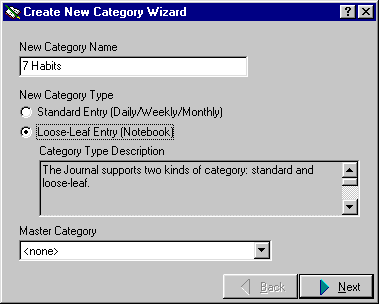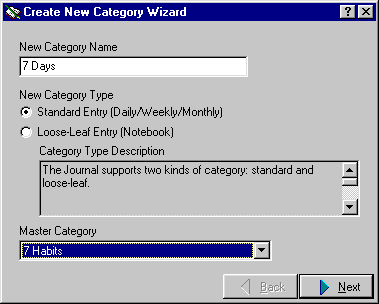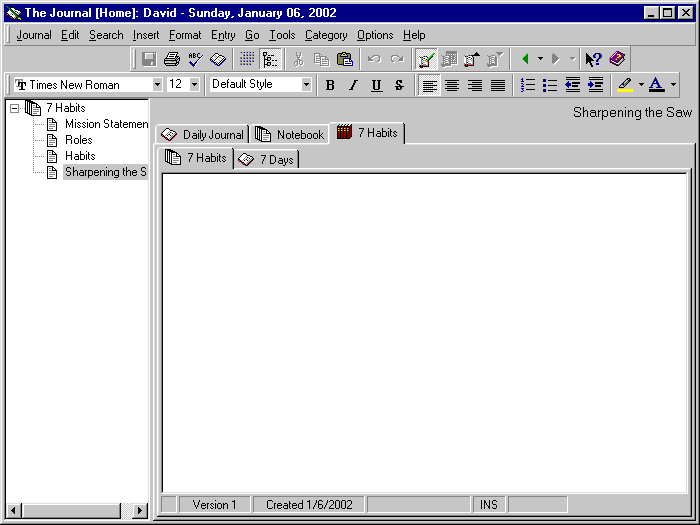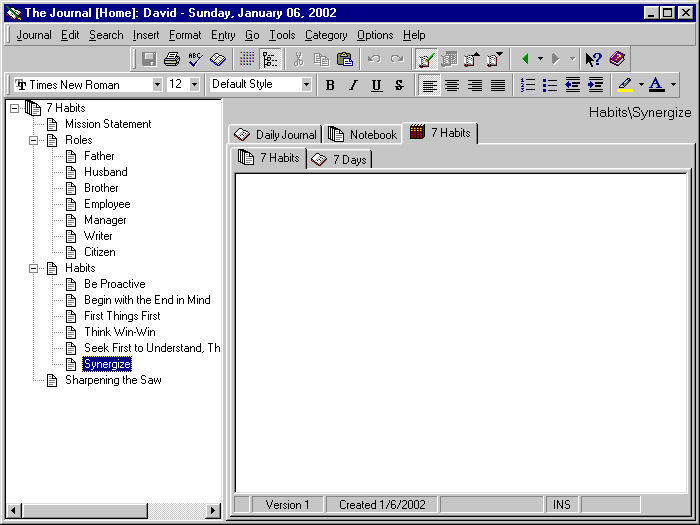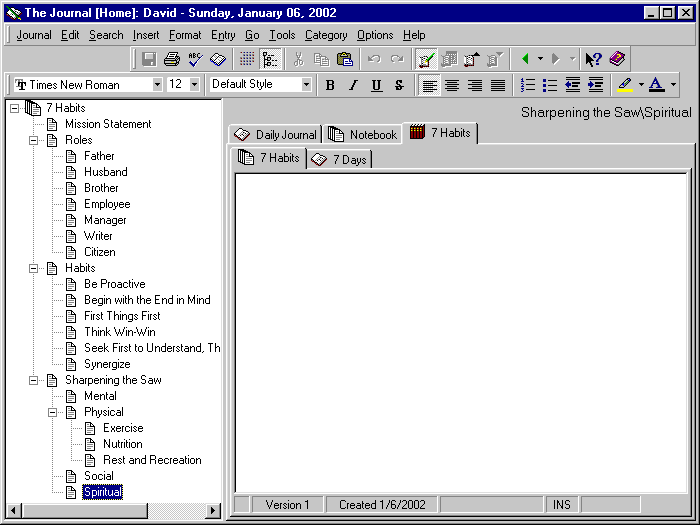The Journal Newsletter
- Introduction
- Tips & Tricks
- Writing Prompts
- How I Use The Journal
- Article: ‘Seven Habits’ and The Journal
- Submission Information
Introduction
Happy New Year!
The Journal 3 Build #23 is now available. See The Journal News below for more information.
Michael Ham gives us another article this month, this time about using The Journal in conjunction with the book “The Seven Habits of Highly Effective People” by Stephen Covey. And even though Linda Harrell doesn’t use The Journal for journaling, she tells what she *does* use The Journal for in this month’s “How I Use The Journal.”
As always, there are new writing exercises and a new tip for using The Journal. So be sure to check those out too.
Thank you for supporting DavidRM Software’s The Journal!
Tips & Tricks
TIP: Using Master Categories
This month’s article (see below) talks about using a Master Category, so this is a more complete description of the feature.
Master Categories allow 1 level of “sub-categories” by placing one category “under” another. That is, if a category has a Master Category specified, then that category’s tab is only visible when the Master Category tab is active.
This feature currently doesn’t support true “tree” structuring of categories. Instead, it allows “logical grouping” of categories under a single heading. So if you have several categories that all relate to the same overall topic, you can select the main category and make that the “Master Category” of the others.
For instance: I have two categories devoted to The Journal development. The first category is “The Journal”, which is a loose-leaf category containing release documentation for (nearly) all versions, as well as the monthly newsletters, marketing write-ups, and so on. I also have a standard category, “The Journal Notes” where I track daily information/notes about The Journal. “The Journal” is the Master Category for “The Journal Notes”. So, only “The Journal” shows up in my main set of category tabs. When I bring up “The Journal” tab, it then displays the tab for “The Journal”, as well as for “The Journal Notes”.
Another example is given in Michael Ham’s article, with the “7 Days” category being created as a “sub-category” of “7 Habits”.
Writing Prompts
by Susan Michael
Free Writing Exercise – Write for 20 minutes without editing using the sense of black and white vision, as in film or photographs. The piece can have a historical or nostalgic feel, surreal, or futuristic.
Poetry Exercise – Write a poem that describes a walk through a house from the perspective of a child.
Prose Exercise – Write about someone discovering a key.
Journaling Exercise – List three things that you do not know how to do.
Example: Fix a leaky faucet.
Continue by explaining why you do not know how to do it.
Example: I have never tried to, or seen anyone fix a leak.
What steps could you take to learn how to do it?
Example: Watch another person as they explain the steps, or use a reference book to guide me through the process.
Then ask yourself if this is something you are capable of doing, or not capable of doing.
Example: I believe I would be capable of doing this.
Next, is this something you would or would not want to do? Explain why.
Example: I would not want to do this because it is too time consuming.
Is this something that you need to know, or something you would like to know how to do?
Example: This isn’t something that I need to know.
Would you benefit from learning how to do this thing? What is an immediate benefit, what would be a long term benefit?
Example: I would benefit from learning how to fix a leaky faucet because I could prevent the water spraying all over the sink. If I knew how to do this then I would not be relying on someone else to do it for me.
Is the benefit strong enough to encourage you to actually learn how to do this?
Example: No, not at this time, the faucet still works.
What would motivate you to learn how to do this thing?
Example: Frustration at the inefficiency, and specifically applying myself to get the job done.
About the author: Susan Michael has facilitated several writing groups, and has lead writing & creativity workshops for the Arts & Humanties Council in Tulsa, Oklahoma.
How I Use The Journal
Editor’s Note: The Journal is used by people from all over the world, from many nations, representing a variety of personal, professional, and religious backgrounds. Journaling is by definition an intensely personal undertaking, so it should not be surprising that when someone writes about how or why they keep a journal that they will end up sharing personal information. The Journal Newsletter does not support any particular personal or religious lifestyle, but rather attempts to support anyone who keeps a journal, for whatever reason they do so. Thus, the views and opinions expressed in “How I Use The Journal” are solely those of the submitter and not necessarily the views of DavidRM Software. Whether you agree with the submitter’s views or not, I encourage you to read the article and glean from it the information and techniques that “ring true” for you.
HOW I USE THE JOURNAL
by Linda Harrell
Ironically enough, I use The Journal for everything EXCEPT journaling.
My biggest problem was keeping track of the STUFF–all that info that you need sometimes, the goals and how you’re doing, etc.
Here’s how I set it up:
1) Goals
I set up 7 goals for this year (Loose weight, exercise, organize, writing, etc)
2) To Do
In here I break down those goals into “Today-call” “Today-do” “Daily schedule” “Monthly Schedule” “Yearly Schedule”
These, I print out and put in the notebook. (I don’t have quarterly, because I’ve assigned them to a month).
But then, I have some extra catagories: Books I want to read; Daughter Visit (A list of things I have to do before my daughter comes for a business–some cleaning, some like making a hotel reservation); Travel List (things to make sure I take when I travel); and even a Wish List to Buy.
3) THINGS DONE!
I don’t think I’ve ever seen anyone recommend keeping track of the things you’ve done. I love it! I can go in there and view by day what I really have accomplished!
4) Records
- Insurance policy #’s
- Credit card #’s
- Financial info (bank numbers, etc)
- Health (when the last Dr visit was & what was needed; questions we want to ask next time; what blood and other tests have been done this year and what needs to be done)
- And a copy of my phone #’s
I email a copy of this information to my daughter for her to keep so if the house burns down I’ll have it. I could just imagine having our house burn down and not having the number for our handyman!
5) E-purchases.
I have this broken down in two ways: daily and by name. Whenever I purchase something on the computer I cut/paste the confirmation in the daily one, so I make sure I get it, and then again under its name so I will have the info on a long term basis.
Hope this helps you all out there think of The Journal as more than just a journal!
-Linda
Article
‘Seven Habits’ and The Journal
A System of Resolutions for the New Year
by Michael Ham
This article presents a method of using The Journal in conjunction with“The Seven Habits of Highly Effective People” by Stephen Covey. It occurred to me that the 7 habits could work well with The Journal, particularly since the 7 habits involve daily application.
Getting Started
The first step is to read Covey’s book-not an easy task, since Covey writes awkwardly and is not always clear about where he is or where he’s going. But his method is truly valuable, and worth the effort to read.
I see two main reasons why his method works so well:
First, he has you think about your life goals (or “mission”, as he calls it) and actually put them into writing-which is a vital step to move them from the realm of idle dreams.
Second, he has you schedule actions each week that will move you toward these goals. For example, if one goal is to learn Spanish, your action in the coming week might be to find out about the local community college’s admissions procedure and costs. Not a big action, but a definite step toward achieving the goal.
This weekly scheduling is an important part of the process. If Covey had used a daily schedule, it would quickly fall by the wayside, overrun by daily emergencies and surprises. And if he hand used a monthly schedule-well, a month’s a long time, and it’s easy to postpone actions until you forget them.
It turns out that a week is just right: long enough that you have time to recover if a day is blasted away by some emergency, but also short enough that you feel a sense of urgency. And so, week by week, you move toward a realization of your life goals.
The 7 Habits
The 7 habits shape how you approach those goals. The first three habits involve only yourself and give you the ability to achieve independence. The second three habits involve your relationship with others-to go beyond independence (which, after all, allows you to accomplish only what you can do alone) to achieve interdependence. (In working on the second three habits, the book Getting to Yes, by Roger Fisher and William Ury, is an extremely useful aid.)
The seventh habit-which actually appears in the book quite early, though not identified as such at that point-is the habit of “sharpening the saw”: taking steps to ensure continuing growth and renewal in four spheres: mental, physical, social, and spiritual.
Setting up The Journal for the 7 Habits
The Journal turns out to work well with Covey’s plan. Here’s one way you can set up The Journal for this effort.
First, create a two new categories: a Loose-leaf (notebook) category named “7 Habits” and a Standard category named “7 Days”. The “7 Days” category should be daily with normal document entries. If you want, you can make the “7 Days” category a sub-category of “7 Habits” by setting its Master Category to “7 Habits”.
In the 7 Habits category, create these top-level entries:
- Mission Statement (or Goals Statement)
- Roles (Covey’s book explains this)
- Habits
- Sharpening the Saw
Under “Roles”, create sub-entries for each of the roles you play (up to a maximum of 7), as Covey discusses. The roles you pick will be those you see as most important for you, but as an example, the roles that I used were:
- Father
- Husband
- Brother
- Employee
- Manager
- Writer
- Citizen
You will use these entries to identify your most important goals for each role, and then make a daily schedule for the coming week (hence the 7 Days category) of actions to move you toward achieving these goals.
Under “Habits”, create sub-entries for each of the first six habits:
- Be proactive
- Begin with the end in mind
- First things first
- Think win-win
- Seek first to understand, then to be understood
- Synergize
Under “Sharpening the Saw”, create the four sub-entries:
- Mental
- Physical
- Social
- Spiritual
Under “Physical”, create three further sub-entries:
- Exercise
- Nutrition
- Rest & recreation
This completes the schema of categories, entries, and sub-entries. How to use these is described in the next section.
Using The Journal with the 7 Habits
The “7 Habits” category is for your evolving plan, thoughts, and understandings of each of the entries.
First is the “Mission Statement.” Here you will describe what you want from your life. This requires time and thought, and your initial attempts will have to be revisited and refined over time. Only you can write this, though, even if you don’t know off the top of your head what you do want. Covey suggests a number of exercises to help you identify what belongs here-for example, you can imagine yourself at the end of your life, looking back. What would give you a feeling of satisfaction and fulfillment as you look back? You need to be conscious about this, because if you simply drift with the years, you’re unlikely to feel as good about your life as you’d like.
As you continue to follow the seven habits discipline, you will often return to this entry as a touchstone-and your experience in following the habits will give you new insights that will change your mission statement over time.
Next, under “Roles”, enter goals for each of your primary roles. For example, one of my goals as “Father” was to have a close relationship with my children, the kind of relationship built on love, understanding, and good communication.
As you set these goals-and review your roles each week-you use the 7 Days category to create entries for the coming week. Select a day in the coming week and enter one or two things you’ll do on that day to advance you toward the goals in your role. Also enter these actions into your appointment book or PDA as scheduled appointments, so that you will have time set aside for them. (You can then fit other things around these key appointments.)
For example, my son was attending college in the same town where I lived, but he lived on campus. Because each week was filled with urgent things, it would have been easy to let a semester-or two-drift by without seeing him. But I scheduled an evening with him each week. We’d have dinner and then do something together-play billiards, see a movie, or do something else. In the course of this, we got to know each other better and he understood how much I valued him. (This is also an example of making sure that important but non-urgent actions are taken, rather than being driven only by urgency.)
As you go through the week, each evening look at the current day in the 7 Days category and describe how the scheduled action worked out-or, if necessary, reschedule the action for later in the week. (I quickly learned that I needed to schedule most actions in the first half of the week and leave the last half empty to accommodate actions that had to be rescheduled.) Then, look at the coming day to remind yourself of tomorrow’s actions.
At the end of the week, evaluate the entire week and how well you succeeded in each of your roles and then schedule new actions for the coming week.
The “Habits” entries collect your reflections on each habit and how you’re progressing toward making it a part of your life. Describe your successes-instances in which you exemplified the habit-and setbacks-where you overlooked opportunities.
Remember that establishing a new habit takes time. Before you start, you’re not even aware of the need for a habit. Then, as you work on it, you get to where you’ll recognize, after the fact, where you failed to implement the habit you want to acquire. At the next stage, you’ll recognize in mid-stride that you’re not doing what the habit requires, so that you can recover on the spot. And finally, the habit will become embedded as part of your normal response. The speed of this sort of change is not the speed of understanding or insight. Rather, it’s the speed of growth, like the growth of a plant: it’s slow, but it does happen.
Your initial focus should be on the first three habits, to create the foundation on which you can build the next three habits. The habit of Sharpening the Saw, though, goes on all the time.
Each habit requires monitoring, but “Sharpening the Saw” requires special attention, since if you don’t keep at it, the saw grows dull and you find that you experience more and more difficulty in those areas of your life you have neglected. On-going attention is required, but there’s a payoff: as you attend to these activities daily, you find that they become easier and-more important-your life becomes easier, because of the strength you get from the exercise in those four critical areas.
Mental – Keeping your mind sharp and your knowledge current by continuing to learn new skills and new perspectives. Read history and biographies as well as management books, poetry and drama as well as the newspaper.
Physical – Your body has a major influence on your state of mind and your fitness for life. Be sure that you eat appropriately and exercise regularly-not only does it give you strength and energy, it acts to prevent type 2 diabetes, a disease that is becoming epidemic in the US although it’s almost totally preventable.
Social – No person can have a fulfilling life without the support of friends and community. Most people desire to maintain connections to family, but making and maintaining friendships is equally as important, and the responsibilities of a citizen are more in our minds following the 9/11 attacks.
Spiritual – Find a way to reach beyond yourself-through meditation, prayer, a stillness with nature, sacred song, or whatever works for you. Pay attention to the need for nourishing and replenishing your spirit-don’t live a life that leaves you wondering, “Is this all?”
Conclusion
That’s the general idea. Read the book, then use The Journal to keep yourself moving toward the achievement of these new habits.
I would be interested to hear how you’ve used and adapted these ideas. You’re welcome to email me at mham@redshift.com.
Michael Ham
mham@redshift.com
December 2001
About the author: Michael Ham has kept a journal intermittently through the years. Only after he read “The 7 Habits of Highly Successful People” did he start to think of it in a new paradigm.
 |
The 7 Habits of Highly Effective People, by Steven R. Covey Simon & Schuster; ISBN: 0671708635 |
Submission Information
If you would like to contribute to the “How I Use The Journal”, “Writing Exercises”, or “Tips & Tricks” sections, or would like to submit an article about journaling, writing, or another The Journal-related topic, we would love to hear from you.
Submissions for the newsletter should be sent to: support@davidrm.com
If you are submitting for a particular section, please indicate which one. Try to limit your submissions to 500-1000 words. Submissions may be edited for length and content.
If you prefer to remain anonymous, please state this in the email. Otherwise your name (but not your email) will be used in the article heading.
As always, if you have any suggestions for, or bug reports about, The Journal, please feel free to email them. Both are always welcome.

